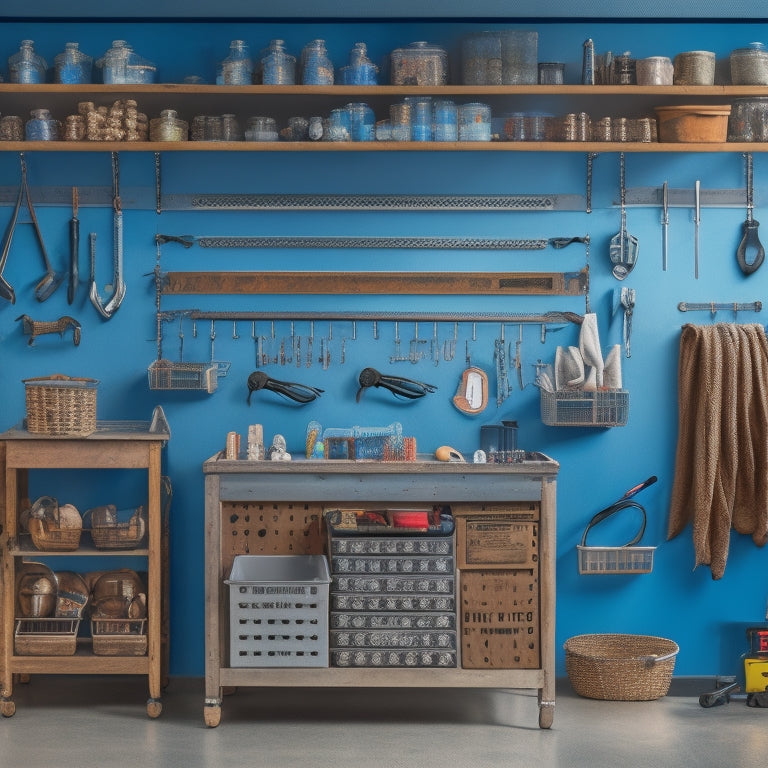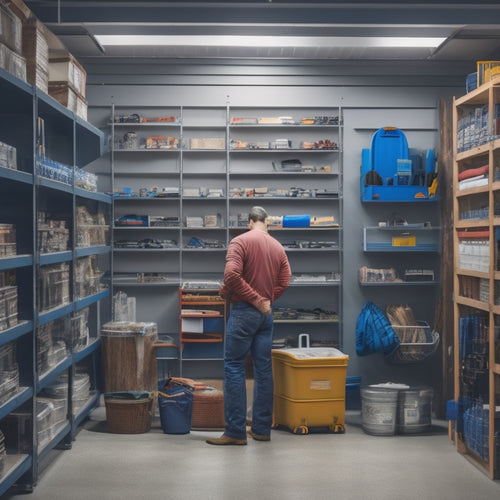
7 Simple Steps to Efficient Shop Tool Storage
Share
You can enhance your shop's productivity by introducing efficient tool storage. Start by evaluating your tool collection, purging unnecessary items, and categorizing tools by function. Then, assign a home for each tool, utilizing vertical storage space to maximize your shop's layout. Implement a maintenance routine to keep your tools in top condition. Label and sign everything to guarantee easy identification and retrieval. By following these 7 simple steps, you'll save time, reduce frustration, and increase your profits - and that's just the beginning of what you'll uncover when you take control of your shop's tool storage.
Key Takeaways
- Assess your tool collection to determine storage solutions, categorize tools, and create an inventory list for tracking and maintenance.
- Purge unnecessary items, including broken, redundant, or obsolete tools, to free up space and focus on efficient tools.
- Organize tools by function and task-based zones to enhance accessibility, ergonomics, and workspace organization.
- Assign a home for each tool using labels, categorization, and color-coding to facilitate efficient retrieval and maintenance.
- Utilize vertical storage space with racks, shelves, and pegboard panels to maximize storage capacity and reclaim floor area.
Assess Your Tool Collection
You've accumulated a vast array of tools over the years, but do you really know what you have? It's time to take stock of your tool collection. Start by gathering all your tools in one place, like a workbench or table. This will give you a clear view of what you have and help you identify any duplicates or obsolete items.
Next, categorize your tools into groups, such as hand tools, power tools, and specialty tools. This will make it easier to see what you have and where it should be stored. Take note of the tools you use frequently and those that are rarely used. This will help you determine the best storage solutions for each category.
Create a tool inventory list to keep track of what you have and where it's stored. This list will also come in handy when you need to replace or repair a tool.
With a clear understanding of your tool collection, you can start planning storage solutions that will keep your tools organized, protected, and easily accessible.
Purge Unnecessary Items
In tandem with your tool inventory, it's vital to purge unnecessary items that are taking up precious space and creating clutter. This step is essential in optimizing your storage solutions and improving workspace aesthetics. By removing unused or broken tools, you'll not only free up space but also reduce the time spent on tool maintenance and improve overall efficiency.
| Reason to Keep | Reason to Purge |
|---|---|
| Frequently used or has sentimental value | Broken or beyond repair |
| Still in good condition and functional | Duplicate or redundant tools |
| Hard to replace or find | Outdated or obsolete tools |
| Has a specific purpose or function | Not relevant to your current projects |
Consider donating gently used tools to a local school, community center, or online organizations. This not only declutters your space but also gives back to the community. By purging unnecessary items, you'll be able to focus on the tools that matter, streamline your workflow, and create a more organized and efficient workspace.
Categorize Tools by Function
You'll find it's crucial to categorize your tools by function, grouping them into categories like drilling, cutting, and measuring.
This process helps you identify the specific functions of each tool, making it easier to decide where to store them.
Tool Groups Defined
Categorizing tools by function is an essential step in efficient shop tool storage. It helps you group similar tools together, making them easy to find and access when you need them.
Start by identifying the main tool types in your shop, such as hand tools, power tools, and measuring tools. Then, categorize each tool type into smaller groups based on their function. For example, hand tools can be grouped into categories like cutting, fastening, and gripping.
Within each group, consider the storage materials you'll need to keep your tools organized and protected. For instance, you may need bins and baskets for small items, hooks for hanging tools, or a pegboard for frequently used items.
Tool Functions Identified
With your tool groups defined, it's time to identify the specific functions within each group. This step is essential in determining the most effective storage solutions for your tools.
Identify the different tool types within each group, such as hand tools, power tools, and specialty tools. Then, categorize them by their specific functions, like drilling, cutting, or measuring.
This exercise will help you develop organization strategies that prioritize tool accessibility and inventory management. Consider the material durability and user preferences when selecting storage solutions. For instance, you may prefer ergonomic design storage options that reduce strain on your body.
As you categorize your tools by function, keep safety considerations top of mind. Guarantee that tools are stored in a way that prevents accidents and injuries. This will also contribute to workspace optimization, as you'll be able to quickly locate the tools you need, reducing downtime and increasing productivity.
Task-Based Storage Zones
Most of your tools can be categorized into distinct task-based storage zones, each containing tools that serve a specific purpose. This approach enables you to optimize tool accessibility, efficient retrieval, and ergonomic placement, ultimately leading to improved workspace organization.
| Task-Based Storage Zones | Tool Examples |
|---|---|
| Assembly and Fabrication | Wrenches, pliers, screwdrivers, hammers |
| Cutting and Shaping | Saws, drill presses, sanders, grinders |
| Measuring and Testing | Calipers, micrometers, multimeters, level tools |
| Finishing and Coating | Brushes, rollers, sprayers, sandpaper |
Assign a Home for Each Tool
You'll save time and reduce frustration by assigning a specific home for each tool, making it easy to find what you need when you need it.
Start by creating tool location labels, so you can quickly identify where each tool is stored.
Next, group similar tools together by category, ensuring that tools used for the same task are stored in the same area.
Tool Location Labels
Every tool in your shop has a designated home, and labeling those locations is essential to maintaining an organized workspace. Labels help you and others quickly identify where a tool belongs, ensuring it gets returned after use. This promotes tool visibility, reduces clutter, and saves time searching for misplaced tools.
Use durable storage materials like plastic or metal labels, or even adhesive-backed labels for smaller areas. You can also use a label maker to create clear, easy-to-read labels. Consider using color-coding to categorize tools by type or function. For example, label all hand tools with a yellow label and power tools with a red label.
When labeling, be specific. Instead of labeling a drawer as "hand tools," label it as "wrenches" or "pliers." This level of specificity helps you and others quickly find the tool you need.
Remember to update labels as your tool collection changes, and consider creating a comprehensive list of tool locations for reference. By labeling tool locations, you'll maintain a safe and efficient workspace.
Tool Category Grouping
With your tool locations labeled, it's time to take organization to the next level by assigning a home for each tool. This is where tool category grouping comes in. Group similar tool types together, such as hand tools, power tools, and measuring tools. This organizational method optimizes space and makes tools more accessible.
When grouping tools, consider the frequency of use, safety considerations, and material durability. For instance, you may want to store heavy or bulky tools near the floor to prevent accidents and make them easier to access. Portable storage solutions like toolboxes or chests can also be used to store tools that are used less frequently.
Implementing an inventory management system will help you keep track of your tools and guarantee that you're not duplicating purchases. Additionally, grouping tools by category makes tool maintenance easier, as you can quickly identify tools that need to be serviced or replaced.
Utilize Vertical Storage Space
By optimizing your workshop's vertical storage space, you can reclaim precious floor real estate and create a more efficient work environment.
Install wall-mounted racks to store infrequently used tools, keeping them out of the way but still accessible. Overhead shelves can hold less frequently used items like seasonal decorations or bulky equipment.
Pegboard panels with hooks and bins can organize hand tools and accessories, while magnetic strips can hold small metal items like wrenches and pliers.
Consider toolboxes with sliding drawers to store small parts and supplies. Creative shelving solutions like stackable bins and baskets can maximize storage capacity.
Make the most of your workshop's vertical space by using space-saving solutions like foldable workbenches and adjustable shelving.
Implement a Maintenance Routine
Now that your workshop's vertical storage space is maximized, it's time to focus on maintaining your tools and equipment to confirm they remain in top condition.
A well-planned maintenance routine is essential to guarantee tool longevity and prevent accidents. Start by scheduling regular inspections to identify potential issues before they become major problems.
Create a cleaning schedule to keep your tools free from dirt and debris, and develop lubrication techniques to keep moving parts running smoothly.
Establish repair procedures to address worn or damaged components, and keep a maintenance log to track your efforts.
Regular safety checks will also help you identify potential hazards and take corrective action.
By implementing these measures, you'll extend the life of your tools, reduce downtime, and create a safer working environment.
Label and Sign Everything
Every tool and storage location in your workshop deserves a clear, concise label. This simple step can save you time and frustration when searching for a specific tool or part. It's also essential for safety, as it helps prevent accidents caused by misused or misplaced tools.
When it comes to labeling, you have several options. You can use:
| Label Type | Best For |
|---|---|
| Adhesive labels | Small tools and storage bins |
| Engraved labels | Metal storage cabinets and tool chests |
| Magnetic labels | Metal tools and equipment |
| Color-coded labels | Organizing tools by category or project |
| Barcode labels | Inventory management and tracking |
Choose a label type that suits your workshop's specific needs. Consider the material you're labeling, the environment, and the level of durability required. Don't forget to use sign materials that are easy to read and understand, such as bold fonts and bright colors. By labeling and signing everything, you'll create a more organized, efficient, and safe workshop.
Frequently Asked Questions
How Do I Store Tools That Require Frequent Charging or Calibration?
You designate a charging station for tools that require frequent recharging, and create a calibration schedule to guarantee they're accurately functioning; this setup helps you stay organized, efficient, and safe while maintaining your tools.
Can I Use Old Furniture to Create Tool Storage Solutions?
Convert your grandma's old dresser into a functional tool haven, just like a skilled carpenter repurposing a vintage chest. You can creatively repurpose old furniture into storage solutions, keeping frequently used tools within easy reach while maintaining a safe and organized workspace.
Are There Any Tools That Should Never Be Stored Together?
You shouldn't store tools with different rust prevention needs together, as moisture from one tool can compromise another. Also, avoid mixing tools with incompatible materials, like aluminum and copper, to maintain tool compatibility and prevent damage or corrosion.
How Often Should I Reorganize My Tool Storage System?
Did you know that 60% of workplace accidents are caused by poor tool organization? You should reorganize your tool storage system every 3-6 months to maintain efficiency, incorporating seasonal storage tips and adjusting tool organization strategies as your projects change.
Can I Store Tools in a Humid or Outdoor Environment?
You shouldn't store tools in humid or outdoor environments without proper moisture control and rust prevention measures, as it can lead to corrosion and damage; instead, use waterproof containers, silica gel packs, or rust-inhibiting coatings to protect your tools.
Conclusion
As you've organized your tools, imagine taming a wild beast - each step a gentle tug on the reins. Now, your workshop is a harmonious orchestra, each tool playing its part in perfect sync. But, like a garden, it requires regular tending to remain beautiful. Stay vigilant, and your tools will remain loyal servants, awaiting your next project. Neglect them, and they'll revert to chaos, hindering your progress. The choice is yours - tend your garden, and reap the rewards of efficiency and productivity.
Related Posts
-

Best Tool Chests for Home Garage Options
When selecting the best tool chest for your home garage, you'll want to evaluate top brands like DeWalt, Milwaukee, a...
-

Building Garage Shelves in 7 Easy Steps
You're about to convert your garage into a highly functional storage space by building custom shelves in just 7 easy ...
-

Heavy-Duty Commercial Rolling Shelving Racks
You need heavy-duty commercial rolling shelving racks that optimize your storage capacity, streamline operations, and...


